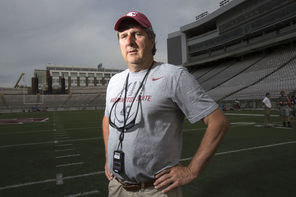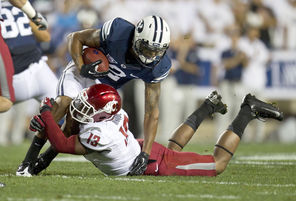Originally published Saturday, August 24, 2013 at 3:15 PM
Cougars’ defensive improvement is all about attitude
If Washington State is going to turn things around, Cougars will have to play better defense.
Seattle Times staff reporter
![]()
PULLMAN – Amid the hurly-burly of a recent Washington State scrimmage, with assistant coaches hollering instructions to their various units, came this reminder from the sideline to linebacker Ivan McLellan: “Ivan! Body language!”
Body language? You’ve got to read your keys, shed blocks, employ a rip move in pursuit of the quarterback, and somebody is worried about ... body language?
Believe it. The Cougars’ long climb back to respectability is laced with all sorts of elements, some of which have as much to do with attitude as they do athleticism.
“We don’t like slouchers at Washington State,” says linebackers coach Paul Volero.
The concept is especially relevant to a defense that just might be sneaky-good in 2013.
“When that offense gets a 60-yard bomb down the field, how are you going to respond?” linebacker Darryl Monroe asked rhetorically. “Are you going to walk with your head down or your chest up? That’s what our coaches are trying to get across.”
It would take a psychologist to parse whether poor body language naturally accompanies a setback on the field, or whether, in the case of the Cougars — scarred by several losing seasons of monstrous proportions — it’s an inevitable here-we-go-again response.
One thing is clear, though. Mike Leach’s first season at WSU was marked by some wild inconsistency, and it’s not unreasonable to assume that some of that rose from a fragile mental state. Ask coordinator Mike Breske how much of the Cougars’ defensive future lies between the ears, and he says, “About 90 percent.”
Thus, says Breske, the prescription: “Go to the next play. Don’t let it linger. We haven’t reached that point yet where we’re just consistently going to the next play.”
Gnaw on these numbers and weigh whether they seem reflective of a 3-9 team a year ago: The Cougars held Stanford’s career-leading rusher, Stepfan Taylor, to 58 yards on 21 carries. Washington’s Bishop Sankey labored to gain 84 yards on 26 tries.
WSU’s run defense, No. 6 in the Pac-12, actually finished ahead of both UCLA and USC. Its 4 yards-per-carry yield tied for third-best.
But there were those mood swings. A week after the Cougars had a first-and-goal at league champ Stanford, down a touchdown in the last minute, they got bum-rushed at Utah, 49-6.
“I think we need to be careful not to hear all the noise, about how many years we’ve had losing seasons and stuff,” says defensive end Logan Mayes. “Each unit needs to really focus on what it needs to do to win and not look at the other units.”
He cites the Utah collapse, when the defense started out all right, “kind of watched the offense a little too much, kind of got discouraged and didn’t think about doing our job.”
Five players on the probable front seven were full-time starters for the first time last year, which should augur improvement — maybe quantum advancement — from 2012. And wouldn’t it be an ironic twist if it was the defense that provided the symbolic takeoff to the Leach regime?
The defense will operate in Breske’s “Fire Zone” scheme, featuring an odd front (convertible to a 4-3 when the “Buck” linebacker plays down), with lots of movement by the linemen and blitzing from linebackers.
“We’re movement-happy,” says Breske. “We’ve got to be able to move the pocket.”
Linemen Xavier Cooper, Junior Gauta and Toni Pole combined for 22.5 tackles for loss last year. When the defense is operating well, you see things like the pressure-caused interception by Pole that almost ended the Apple Cup in overtime.
“Coach Joe (line assistant Joe Salavea) says we have to stop the run on the way to the quarterback this year,” says Cooper. “That’s our philosophy.”
Monroe, the middle linebacker, could be in for a big year if the line performs. He’s flanked by two ‘backers who debuted as starters last year, Cyrus Coen and Justin Sagote.
The wild card is 6-foot-4, 290-pound Destiny Vaeao, moved from defensive end to Buck linebacker, the spot occupied last year by Travis Long. The position requires down line and coverage skills, and while Vaeao is raw on pass drops, his coaches seem willing to ride out the adjustment.
After a recent scrimmage, Leach waxed on about Vaeao, saying, “He’s a big, old monstrous guy. He obviously can rush the passer and stop the run.”
It’s the secondary, termed candidly by Breske not long ago “our Achilles,” where WSU’s defensive fortunes could be written. Safety Deone Bucannon was second-team all-Pac-12 a year ago, but the unit seemed to backslide overall, allowing 262.7 passing yards per game, 10th in the Pac-12. Cornerback Damante Horton’s four career interceptions came in 2011, and at the other corner, Nolan Washington’s starts dipped from 12 in 2010 to seven in 2011 to three last year.
“We’ve got to get more of a fierce, competitive personality,” says Breske, talking secondary.
If there’s a fount of self-assuredness on the unit, it’s up front.
“The D-line does a great job; they walk around with a real sense of confidence in themselves and their ability to play,” says offensive-line coach Clay McGuire. “I think our O-line sees that says, ‘If they can do it, why not us?’ ”
Why not us? It might be a suitable mantra for the WSU defense.
| Cougars defense | ||
| Washington State coach Mike Leach is known for his innovative, high-powered offenses. But the Cougars’ defense will need to improve for WSU to make a real turnaround. Here’s how the Cougars stacked up compared to other Pac-12 teams the past two years (all games). | ||
| Category | 2012 rank, by the numbers | 2011 rank, by the numbers |
|---|---|---|
| Scoring defense | 10th, 33.7 points per game | 9th, 31.8 points per game |
| Total defense | 9th, 425.9 yards per game | 6th, 409.6 yards per game |
| Rushing defense | 6th, 163.2 yards per game | 7th, 157.2 yards per game |
| Passing defense | 10th, 262.7 yards per game | 6th, 252.4 yards per game |
| Pass defense efficiency | 11th, 143.9 efficiency rating | 11th, 153.0 efficiency rating |
| Interceptions | 8th, 15 INT, 202 return yards | 10th, 8 INT, 173 return yards |
| Sacks | 5th, 35 sacks, for 241 yards | 10th, 17 sacks, for 102 yards |
| First downs allowed | 6th, 22.8 per game | 3rd, 19.6 per game |
| Opponent 3rd-down conversions | 12th, 45.4 percent converted | 8th, 42.7 percent converted |
| Turnover margin | 11th, minus 9 (21/30) | 9th, minus 4 (17/21) |
| Red-zone defense | 2nd, opponents scored 76.8 percent | 6th, opponents scored 81.0 percent |













